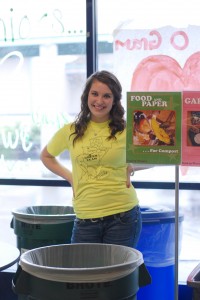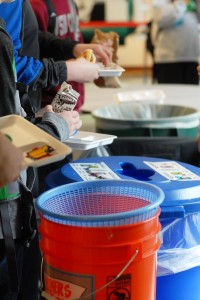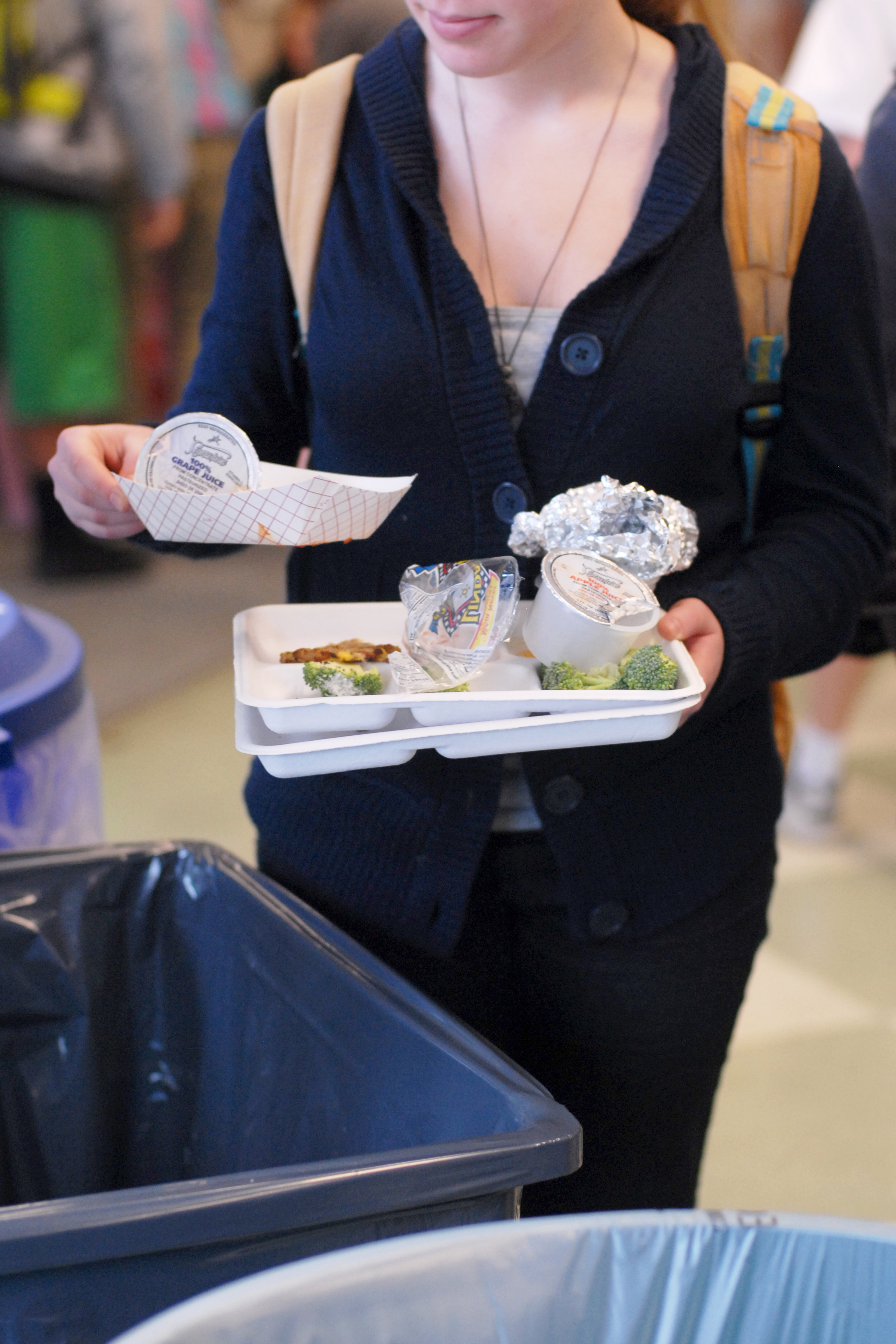By Leslie Merchant

Ever wonder what happens to all of that food and plastic that gets tossed by students at lunchtime?
Leftovers, single use plastic utensils, cardboard containers, it all has to go somewhere. That someplace is the landfill, where it grows and festers waiting for someone to deal with it. Food to Flowers (F2F) is a groundbreaking recycling, composting and waste prevention program developed to tackle the garbage mountain growing in our landfill.
Peter Guttchen, Education and Outreach Specialist with Thurston County Department of Publics Works, worries about the mountain everyday. In fact, he has spent most of his career thinking about it. “Schools are like mini cities with what they throw away,” Peter explains. “Most of what is thrown out in schools is food, on average about 65% of it.” To put that into perspective, consider a waste audit conducted at Black Lake Elementary School in 2011. An estimated 8640 pounds of food and paper (4.3 tons) were thrown away last year. Add the other school garbage to the total and the number increased to 11,988 pounds (6 tons) of waste generated by one school alone.
Multiply that amount by the number of schools in the district and the total is staggering. All of that waste is hauled to a large, regional landfill 240 miles away in Klickitat County, WA. Peter Guttchen and the Department of Public Works have figured out a clever way to drastically reduce the amount of garbage deposited at the waste disposal site, while concurrently generating compost and fill for various city and county projects. Nurseries, farmers, and even street construction are just some of the organizations that have a need for quality compost and fill. Food to Flowers fills that need, teaches children valuable lessons and reduces the amount of garbage thrown out all at the same time.
The changes that F2F advocates are common sense. Replacing trays and single use utensils with durables (reusable plates, bowls, cups, flatware), slicing fruit into smaller portions, bulk dispensers, all are shown to drastically reduce trash. The atmosphere becomes more like that of a restaurant than a school cafeteria. Another change is to schedule lunch after recess, which has been shown to increase the amount of time spent thoughtfully consuming food and drink. Eating before recess often encourages students to rush through lunch in favor of going out to play.
 Peter hopes to revolutionize single use milk carton waste by installing milk dispensers in schools. Students control the amount of milk they take, and the milk itself is colder and fresher due to its being kept in five-gallon vacuum-sealed bags. Thurston County schools toss over 5,000,000 cartons per year, and recycling is only possible overseas as the state does not have the type of facility required to process the cartons. An eight-ounce carton of milk is often too much for little kids and too little for big kids. A trial at local high schools has shown that students immeasurably prefer the serve yourself option to the pre-portioned variety currently available. As of October first, six schools in the Olympia School District will be utilizing milk dispensers.
Peter hopes to revolutionize single use milk carton waste by installing milk dispensers in schools. Students control the amount of milk they take, and the milk itself is colder and fresher due to its being kept in five-gallon vacuum-sealed bags. Thurston County schools toss over 5,000,000 cartons per year, and recycling is only possible overseas as the state does not have the type of facility required to process the cartons. An eight-ounce carton of milk is often too much for little kids and too little for big kids. A trial at local high schools has shown that students immeasurably prefer the serve yourself option to the pre-portioned variety currently available. As of October first, six schools in the Olympia School District will be utilizing milk dispensers.
It is during the initial data collection and daily program requirements that students are actively involved in F2F. The idea is that beginning in elementary school and continuing through middle and high school, students are engaged in being responsible for their environment. “The hands-on education makes a life long difference,” says Peter. “The primary benefit beyond environmental is that now we’re having students from kindergarten on learn stewardship, take home the lessons to their families and have an expectation (from themselves and their families).”
Another advantage of the F2F Program is that it actually saves schools money by reducing what is spent on garbage disposal. “They are wasting a lot on waste. It is an unrecognized source of savings for a district,” says Peter. Tumwater High School Head Custodian Rick Eberle is a huge champion for the program. “We saved over $6,300 from February to June 2012 in garbage costs and pick up charges; we have big plans for this year to try to double that and save $12,000,” he enthusiastically explains.
Students play a huge part in the program. Participating schools have disposal stations that are monitored by F2F students. They help peers identify where items go in the “sort line,” where bins are clearly labeled for disposal of milk, silverware, recyclables, trash and food. The F2F volunteers sort though incoming waste to make certain it lands in the correct container. Each school develops its’ own rotation for student volunteers.

The Food to Flowers program is carefully divided into five distinct stages, which makes it easy for schools to implement. After an initial “waste audit” is conducted, school officials take part in deciding whether or not they can meet the requirements necessary to make the program successful.
The next stages involve planning with a focus on waste prevention and reduction. F2F is then presented to the entire school and two weeks of support and data collection take place. The final stage entails monitoring and a follow up waste audit. Check-in visits, data updates and additional waste prevention and diversion strategies are implemented.
30 schools are already participating in the program. Peter hopes to see that number climb as Food to Flowers takes root in the community. For more information on how schools are saving the earth one milk carton at a time, check out the website www.co.thurston.wa.us/solidwaste or contact Peter Guttchen at guttchp@co.thurston.wa.us

















































